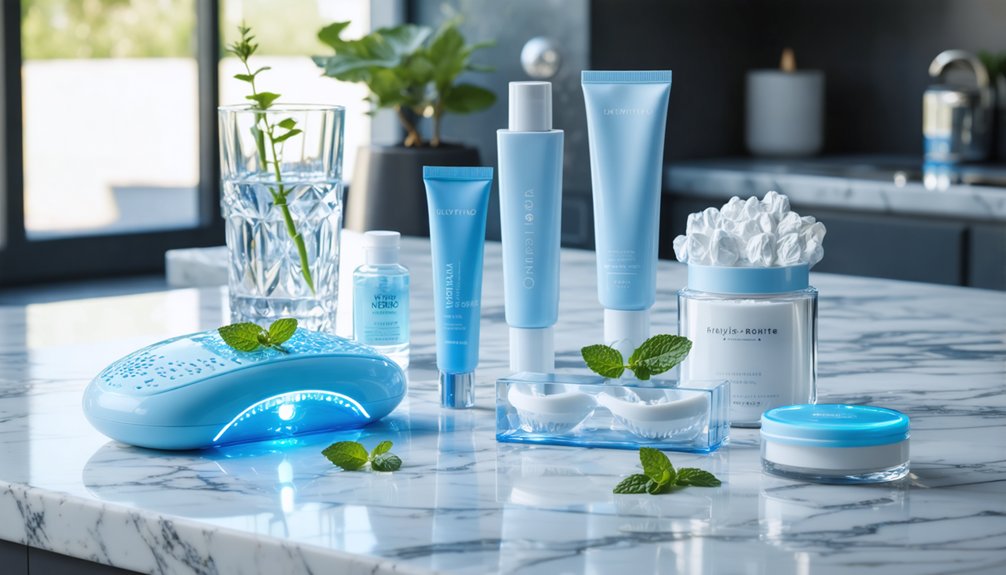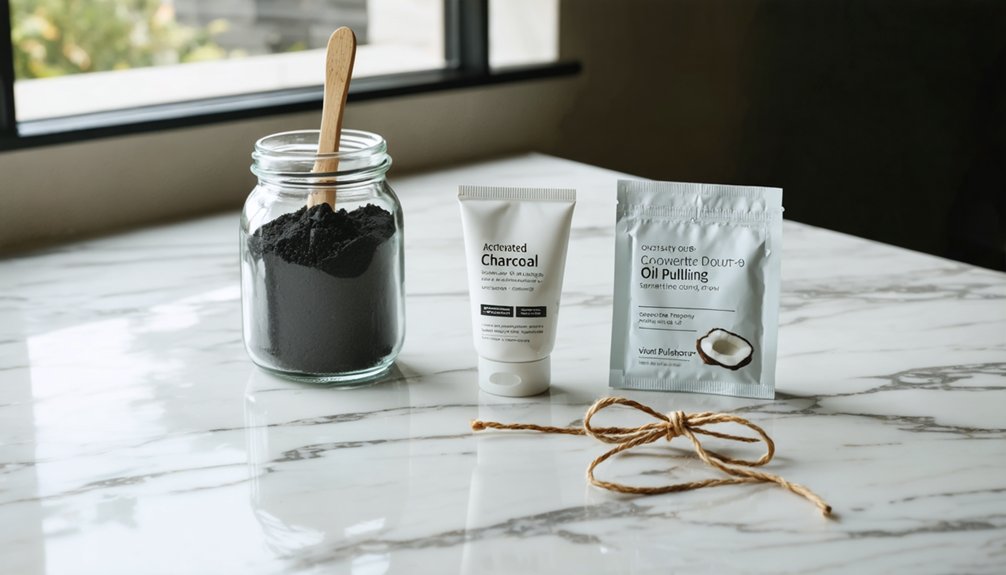You can effectively whiten sensitive teeth through three proven methods. Professional in-office treatments like Philips ZOOM® provide rapid results while incorporating desensitizing agents. Gentle at-home products, including low-concentration whitening strips and specialized toothpaste, offer gradual improvement. Daily care practices such as proper brushing technique and avoiding staining beverages help maintain results. Understanding these approaches will help you achieve a brighter smile while protecting your sensitive teeth.
Key Takeaways
- Professional in-office treatments like Philips ZOOM® provide controlled whitening with desensitizing gels to minimize discomfort.
- Use gentle at-home whitening products containing potassium nitrate or fluoride, like Sensodyne Extra Whitening toothpaste.
- Choose low-concentration whitening strips designed for sensitive teeth, such as Crest 3D White Whitestrips Gentle Routine.
- Brush with soft-bristled toothbrushes and non-abrasive fluoride toothpaste to maintain oral health during whitening.
- Schedule regular dental check-ups to monitor sensitivity and ensure safe whitening progress while maintaining results.
Professional In-Office Whitening Treatments for Sensitive Teeth
While professional in-office teeth whitening offers the most dramatic results, patients with sensitive teeth require specialized treatment protocols to achieve ideal brightening safely.
Modern techniques like Philips ZOOM® combine powerful whitening agents with treatment lights specifically designed to minimize discomfort while delivering rapid results. Dr. Tai uses advanced ZOOM! systems to ensure optimal outcomes.
Your dentist may recommend laser whitening, which can achieve up to 7-10 shade improvements using specially activated hydrogen peroxide gels.
Professional supervision during treatment provides fast visible results while maintaining safety throughout the entire process.
Before treatment, they’ll evaluate your teeth for decay or gum disease that could increase sensitivity. During the procedure, they’ll apply desensitizing gels and monitor exposure times carefully.
Custom-fit trays can protect sensitive areas while ensuring effective whitening. After treatment, you’ll receive fluoride varnishes or additional desensitizing agents to prevent post-procedure discomfort, along with specific instructions for maintaining your results.
Gentle At-Home Whitening Products and Methods
For those seeking alternatives to professional treatments, several gentle at-home whitening options exist specifically for sensitive teeth.
You’ll find specially formulated whitening toothpastes like Sensodyne Extra Whitening that combine desensitizing ingredients with mild bleaching agents.
For more intensive care, low-concentration kits such as Crest 3D White Whitestrips Gentle Routine offer controlled whitening without excessive irritation.
Natural remedies can also provide subtle whitening effects. Consider using diluted hydrogen peroxide or occasional baking soda treatments to remove surface stains. These treatments work by penetrating the enamel to address discoloration beneath the surface.
Gentle formulas containing potassium nitrate or fluoride help protect nerve endings during the whitening process.
Regular dental check-ups help ensure that whitening methods are working safely and not causing additional sensitivity.
Remember to follow application guidelines carefully, limiting sessions to 30 minutes daily and incorporating fluoride treatments afterward to strengthen your enamel and minimize sensitivity.
Daily Care and Prevention Strategies for Whiter Sensitive Teeth
Maintaining white teeth while managing sensitivity requires a carefully balanced approach to daily oral care.
You’ll need to establish consistent oral hygiene practices using a soft-bristled toothbrush and non-abrasive fluoride toothpaste. Brush gently twice daily and floss regularly to prevent plaque buildup that can lead to staining.
Make strategic dietary modifications by limiting exposure to staining beverages like coffee and red wine. When you do consume these drinks, use a straw and rinse immediately with water afterward. Consider using carbamide peroxide products for gentle whitening at home.
Smart sippers minimize stains by using straws for coffee and wine, plus rinsing with water right after drinking.
Choose calcium-rich foods to strengthen your enamel, and avoid extremely hot or cold items that can trigger sensitivity. Regular professional cleanings and maintenance will help preserve whitening results while preventing new stains from developing. Incorporate desensitizing toothpaste into your routine, especially before and after whitening treatments, to help block nerve pain and protect exposed dentin.
Frequently Asked Questions
Can Medications Affect Tooth Sensitivity During Whitening Treatments?
Your medications can considerably affect sensitivity levels during teeth whitening. Different medication types may alter oral health, immune responses, and nerve reactions, increasing your risk of experiencing heightened tooth sensitivity.
How Long Should I Wait Between Whitening Sessions for Sensitive Teeth?
You’ll need to wait 2-4 weeks between at-home whitening sessions, adjusting whitening frequency based on your sensitivity levels. For professional treatments, space them 6-12 months apart for ideal safety.
Will Previous Dental Work Affect the Whitening Results on Sensitive Teeth?
Your dental work won’t whiten like natural teeth. Different whitening techniques can’t change the color of crowns, fillings, or veneers, so you’ll need to consult your dentist to match existing dental materials.
Can Pregnancy or Breastfeeding Impact Tooth Whitening Safety for Sensitive Teeth?
You shouldn’t whiten teeth during pregnancy or breastfeeding, as pregnancy hormones increase sensitivity and there’s limited breastfeeding safety data. Wait until after weaning and consult your dentist for safe options.
Does Age Influence How Sensitive Teeth Respond to Whitening Treatments?
Over 65% of adults experience age-related tooth sensitivity. Your teeth’s response to whitening varies considerably with age factors, as you’ll notice increased sensitivity variations during treatment if you’re younger or elderly.
References
- https://harborcreekdental.com/whitening-sensitive-teeth-what-you-need-to-know/
- https://www.snc.dental/blog/how-to-safely-whiten-sensitive-teeth/
- https://www.sensodyne.com/en-us/oral-health-tips/whitening-sensitive-teeth/what-to-know/
- http://www.goochlanddentistry.com/whats-the-best-teeth-whitener-for-sensitive-teeth/
- https://www.parkcreekdentalcare.com/blog/teeth-whitening-for-sensitive-teeth-safe-options-that-work/
- https://www.goodrx.com/conditions/dental-care/sensitive-teeth-after-whitening
- https://pmc.ncbi.nlm.nih.gov/articles/PMC4058574/
- https://www.drbobsdentalcare.com/is-teeth-whitening-safe-for-sensitive-teeth/
- https://www.madisondentalart.com/blog/professional-whitening-for-sensitive-teeth-facts-and-tips
- https://www.goodmandentalcenter.com/blog/i-have-sensitive-teeth-can-i-still-get-teeth-whitening-treatment



